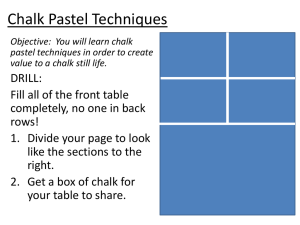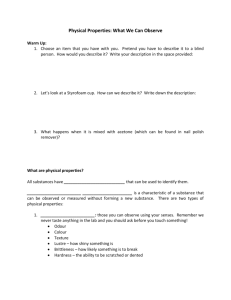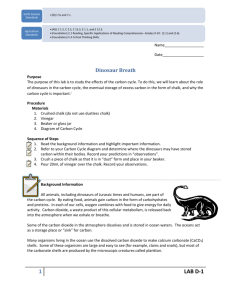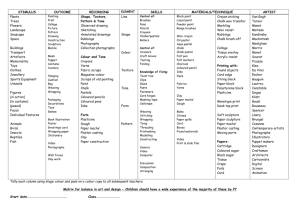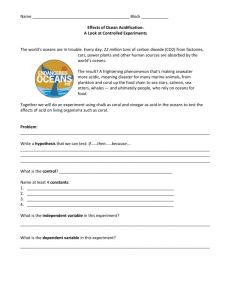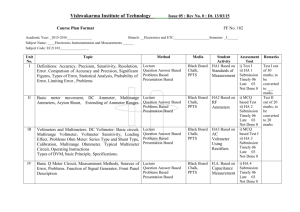26Oct07
advertisement
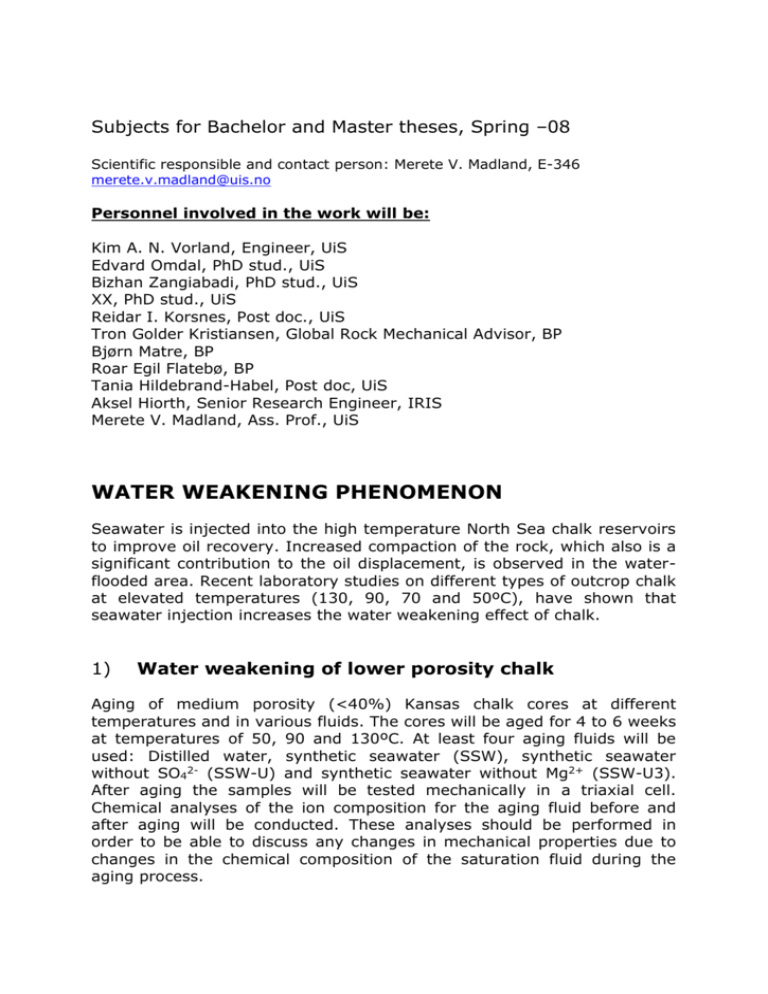
Subjects for Bachelor and Master theses, Spring –08 Scientific responsible and contact person: Merete V. Madland, E-346 merete.v.madland@uis.no Personnel involved in the work will be: Kim A. N. Vorland, Engineer, UiS Edvard Omdal, PhD stud., UiS Bizhan Zangiabadi, PhD stud., UiS XX, PhD stud., UiS Reidar I. Korsnes, Post doc., UiS Tron Golder Kristiansen, Global Rock Mechanical Advisor, BP Bjørn Matre, BP Roar Egil Flatebø, BP Tania Hildebrand-Habel, Post doc, UiS Aksel Hiorth, Senior Research Engineer, IRIS Merete V. Madland, Ass. Prof., UiS WATER WEAKENING PHENOMENON Seawater is injected into the high temperature North Sea chalk reservoirs to improve oil recovery. Increased compaction of the rock, which also is a significant contribution to the oil displacement, is observed in the waterflooded area. Recent laboratory studies on different types of outcrop chalk at elevated temperatures (130, 90, 70 and 50ºC), have shown that seawater injection increases the water weakening effect of chalk. 1) Water weakening of lower porosity chalk Aging of medium porosity (<40%) Kansas chalk cores at different temperatures and in various fluids. The cores will be aged for 4 to 6 weeks at temperatures of 50, 90 and 130ºC. At least four aging fluids will be used: Distilled water, synthetic seawater (SSW), synthetic seawater without SO42- (SSW-U) and synthetic seawater without Mg2+ (SSW-U3). After aging the samples will be tested mechanically in a triaxial cell. Chemical analyses of the ion composition for the aging fluid before and after aging will be conducted. These analyses should be performed in order to be able to discuss any changes in mechanical properties due to changes in the chemical composition of the saturation fluid during the aging process. 2) Fluid substitution and water weakening impact on acoustic velocity This work will look into initial testing evaluation i.e. how predictable existing rock physics models are for chalk that is suffering from water weakening. 3) SEM study of water weakened chalks Possible precipitates in seawater flooded chalks will be analyzed by SEM. Prior to any SEM studies, series of cores, which have been exposed to mechanical tests with seawater flooding at reservoir temperatures, will be prepared. SEM investigations of precipitation at outlet and in pore space will thereafter be performed and with SEM and EDS any distinction of precipitates may then be detected. 4) SEM imaging SEM imaging of chalk and sandstone as input to a 2D pore network model. The work will include sample impregnation, grinding & polishing, SEM imaging, simple image analysis as well as examples from a modelling tool. 5) Reservoir compaction behaviour simulation of Ula sandstones for reservoir BP contact: Tron G. Kristiansen The water weakening effect observed for chalk may also take place for other types of rocks. Reservoir sandstone at Ula undergoes high effective stresses at high temperatures and how will compaction of this reservoir rock be affected by seawater injection? Creep (time dependent behaviour) and possible water weakening effects should be studied. 6) Possible pore pressure build-up injection/water-weakening of chalk during water The pore pressure and compaction behaviour of collapsible materials, such as high porosity chalk, undergoing yield is dependent on the rate of fluid expulsion from the failing pore structure. In conventional experiments (unless imposed deformation rates are unrealistically fast) full drainage of the fluids occurs which gives a simple representation of the yield behaviour. This is not necessarily representative of the situation in a producing reservoir. In a reservoir undergoing production, the quantity of fluid leaving the pore structure of the reservoir rock is restricted to the net voidage rate. Under these conditions, particularly if the reservoir material exhibits a range of porosity’s, then different parts of the reservoir may experience pore collapse under partially drained conditions and fluid pressures will not fall to the extent predicted by conventional engineering analysis for that particular voidage rate. It is proposed that the following study should be undertaken to characterise the pore pressure response of chalks undergoing yield under partially drained conditions. A limited experimental study in which chalks of different initial porosity are deformed to beyond pore collapse under conditions of partial drainage. Small volumes of fluid would be incrementally produced from the samples and their pore pressure and compaction would be monitored. The experiments will explore the impact of initial porosity, voidage rate and fluid compressibility on the pore pressure response. 7) Effective stress law for inelastic weak rocks The effective stresses that rocks are exposed to is a function of several parameters such as; total stress, pore pressure as well as compressibility factors. From a geomechanical point of view; an improved knowledge of the influence of each of the parameters will be of importance in order to gain a deeper insight into the mechanical behaviour of reservoir rocks during oil production. The proposed work will be part of an ongoing project in which the history of important North Sea chalk reservoirs will be simulated. BACKGROUND: Literature study relevant literature considering effective stresses in various rocks search for any parallels between soil –and rock mechanics Experimental study determine Bulk og Youngs modulus as well as Poisson’s ratio determine the Biot-factor 8) Wettability and chalk strength The objective of this task is to investigate the influence of different wetting conditions on the mechanical stability of chalk. The relationship between chalk strength and wettability is an important parameter both for reservoir compaction and enhanced oil recovery. Improved oil recovery from carbonates will in some cases involve wettability alteration towards more water-wet conditions, and previous work at UiS has shown that there is a relationship between reservoir compaction rate and wettability, which may also influence the selection of enhanced oil recovery method. Series of cores with different wettabilities will be prepared and thereafter the samples will be mechanically tested by use of a thermostatic triaxial cell. The cores will undergo different stress regimes and tested at reservoir temperatures. This work will be part of an ongoing project at our laboratory. 9) “The Chalk Bible” BP contact: Tron G. Kristiansen This will be a summary report of the mechanical behaviour of chalk in general. It will focus on the laboratory testing performed at UiS through the years, but will also need to reference key reports and papers. Inhouse laboratory data from BP may also be released and included. The JCR VI database should also be used. The report will start out with the basic parameters (tensile strength, cohesion, internal friction angle, uniaxial yield and hydrostatic yield and the elastic parameters) and how they vary with initial porosity and mineralogy and with plastic deformation (compaction). One should also look at volumetric strain (porosity changes) during deformation and associated permeability changes. One needs to look at the behavior of fractures in chalk in terms of deformation and permeability changes. Also the work on water weakening in chalk up to the current level of understanding should be summarized. At a later stage one will also start to look at other effects such as relative permeability, wettabillity etc. This is an extensive work and it will require close cooperation between the students and experienced chalk research personnel. This project will need to be performed in stages, so the exact scope for each student will be agreed with Merete V. Madland. 10) Produced water injectivity BP Contact: Bjørn Matre, e-mail: matrebj@bp.com , Office Ph.52014170, Mobile Ph. 93482972 Produced water re-injection on Valhall will be critical to meet BP standards and the government’s environmental regulations in the future. Produced water deposited to the sea represents an environmental risk. At Valhall produced water will increase over the years ahead as water injection is progressing. Produced water contains solids, hydrocarbons and the salinity is different from sea-water. It is a major concern that the re-injected water may have a negative impact on the injectivity due to build up of particles on the chalk surface. To address the injectivity issue, a laboratory test program including flooding experiments on outcrop chalk and examination of a possible filtercake has been proposed. The test program includes 9 flooding tests. 3 tests with produced water from Valhall 3 tests on the same cores, where some of the chalk on the inlet side is removed. 3 tests with sea water Viscosity measurements of the water used in the tests on inlet and outlet end. Examination of filtercake on filterpaper and chalk in the Scanning Electron Microscope The flooding has to be done until a decline in injectivty is recorded, which may involve flooding of several 100s pore volumes. Estimated time for every test is approximately one week, but depending on when the decline in injectivity is registered; adjustments has to be made. 11) “Valhall sqz scale inhibitors” BP contact: Roar Flatebø Background: Scale inhibitors approved for Valhall, has been proven to weaken the chalk significantly. The testing has been part of a master thesis at the University of Stavanger with the title “Stimulation fluid and their effect on chalk “. However, further testing is needed to evaluate and find a new scale inhibitor to meet with Valhall requirements. Objectives: Do required laboratory testing to find a scale inhibitor that meets the requirements for Valhall. MECHANICAL PROPERTIES OF CHALKS 12) Chalk liquefaction Late Prof. Risnes (UiS) and Flatebø (now BP) have extruded and liquefied chalk around openings (perforations) and flowed the chalk out of the cell. If a filter paper was used the chalk did not flow. More work is needed in the laboratory to understand if there is minimum opening that will produce a stable geometry or not and what this opening size is for a given chalk. This work could be performed either using the stress controlled cell used by Flatebø or the extrusion cell used by Risnes, but ideally both types of tests may be performed. 13) Mechanical properties of low porosity chalk The mechanical properties of low porosity chalk should be further investigated. Series of compression tests, hydrostatic tests as well as tensile tests should be performed on dry -and water saturated chalk. From these tests, yield strength and complete yield curves, cohesion, friction – and failure angle, elastic parameters such as K-modulus (bulk modulus), E-modulus (Youngs modulus), and Poissons ratio () could then be determined. 14) Variation in friction angle The friction angle is linked to the shear strength or the cohesion of the rock. From previous studies, in-house studies as well as others, the friction angle for chalk, seems to vary according to which stress path the samples have been exposed to. The friction angle seems, however, also to depend on the saturating fluid as well as the testing temperature. This study will include a systematical type of work. Series of chalk samples should be deformed to different stages of plastic deformation. At least 3 to 4 samples of tests are needed at each level of plastic strain. Also different types of saturating fluids should be tested. If time allows, one should also perform tests at different temperatures. 15) Chalk erosion tests Among others, work carried out by Malmin, Flatebø and Omdal (all performed at the chalk laboratories at UiS) has looked at deformation of cavities in chalk. In these tests we are interested in defining better what role the erosion may have in triggering instability in chalk. In order to do so, one will use hollow cylinders with flow from the circumference and maybe axially towards the small wellbore. Some of the hollow cylinders will be filled with proppant material (ceramic grains) to keep them open at higher stress levels. Different stress levels will be investigated and the volume of chalk transported out of the cell with time will be quantified using a digital balance. One will also investigate any effect when using different fluids (water, oil and gas) and combination of them to better understand erosion and deformation interaction. 16) Chalk strength as a function of plastic strain along different stress paths Evaluation of how strength properties in various chalks are gradually reduced as a function of plastic deformation along different stress paths. This data can be used to calibrate chalk models for predicting shear failures and other failures associated with the shear failure line. 17) Acoustics and mechanical anisotropy This project will determine the relationship between acoustic and mechanical anisotropy in various chalk types. The plugs will be drilled in at least 3 different directions relative to a defined bedding and acoustic velocities will be measured as the plugs are failed in shear. 18) Relative permeability as function of compaction Relative permeability is a key parameter in order to predict accurately the recovery in chalk fields. Studies on permeability changes in chalk have been performed, but little data exist on how water-oil, gas-oil and watergas and 3-phase relative permeabilities are changing as a function of compaction. This work will start to look into this aspect in more detail.
